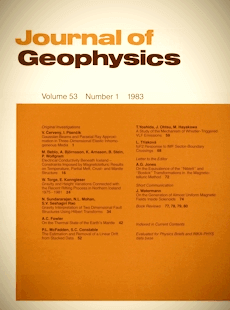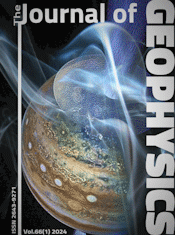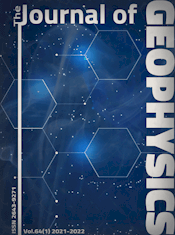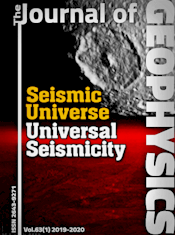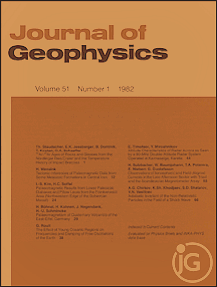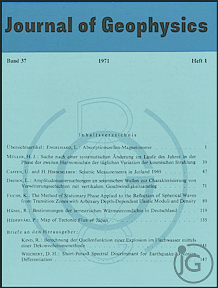Experimental data on electric field and electron density dependence of auroral E-region drift turbulence and radar backscatter
Article Sidebar
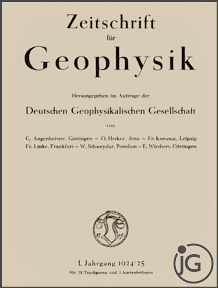
Vols. 1-18 (1924-1944), ISSN 0044-2801
Main Article Content
Abstract
Haldoupis et al. (1982), Uspensky et al. (1983) and Starkov et al. (1983) have recently found that the 140 MHz backscatter amplitude in the auroral ionosphere depends mainly on the mean electron density (height-integrated conductivity) in the E–layer. A similar relationship for the 46 MHz band was also found by Leinonen et al. (in press, 1983). In principle, this can be explained by only a slight dependence of the relative level of E-region drift turbulence < (∆N/ N)2 > in the auroral ionosphere on ionospheric parameters, viz. electric field and mean electron density. However, up to now, quantitative evidence for such a backscatter amplitude — electron density relationship is restricted to the few events which have so far been analyzed. Therefore, the aim of this short note is to add some more data to that data set. Furthermore, we will compare measurements made in the evening and morning sectors, where the conditions for irregularity excitation might be different.
 ARK: https://n2t.net/ark:/88439/y063050
ARK: https://n2t.net/ark:/88439/y063050
Permalink: https://geophysicsjournal.com/article/196
Article Details
References
Baumjohann, W., Greenwald, R.A., Kuppers, F. (1978) Joint magnetometer array and radar backscatter observations of auroral currents in Northern Scandinavia. J. Geophys. 44:373-383
Chestnut, W. (1968) Low frequency waves and irregularities in the auroral ionosphere as determined by radar measurements. In: D'Angelo, N. (Ed.) Low frequency waves and irregularities in the ionosphere, pp. 173-191. D. Reidel, Dordrecht
Fejer, B.G., Kelley, M.C. (1980) Ionospheric irregularities. Rev. Geophys. Space Phys. 18:401-454
Greenwald, R.A., Ecklund, W.L., Balsley, B.B. (1975) Radar observations of auroral currents. J. Geophys. Res. 80:3635-3641
Greenwald, R.A., Weiss, W., Nielsen, E., Thomson, N.F. (1978) STARE: A new radar auroral backscatter experiment in northern Scandinavia. Radio Sci. 13:1021-1039
Haldoupis, C., Nielsen, E., Goertz, C.K. (1982) Experimental evidence on the dependence of 140-Megahertz radar auroral backscatter characteristics on ionospheric conductivity. J. Geophys. Res. 87:7666-7670
Kiippers, F., Untiedt, J., Baumjohann, W., Lange, K., Jones, A.G. (1979) A two-dimensional magnetometer array for ground-based observations of auroral zone electric currents during the International Magnetospheric Study (IMS). J. Geophys. 46:429-450
Leinonen, J., Kangas, J., Kustov, A.V., Stepanov, G.S., Uspensky, M.V. (1983) PiC magnetic pulsations and variations of ionospheric electric field and conductivity. J. Atmos. Terr. Phys. 45 (In press)
Mareschal, M., McDiarmid, D.R., McNamara, A.G. (1979) Some properties of diffuse radio aurora at high aspect angles. J. Geophys. Res.84:6687-6690
Nielsen, E., Schlegel, K. (1983) A first comparison of Stare and Eiscat electron drift velocity measurements. J. Geophys. Res. 88 (In press)
Siren, J.C., Doupnik, J.R., Ecklund, W.L. (1977) A comparison of auroral currents measured by the Chatanika radar with 50 MHz backscatter observed from Anchorage. J. Geophys. Res. 82:3577-3584
Starkov, G.V., Oksman, J., Uspensky, M.V., Kustov, A.V. (1983) On the dependence of radar amplitude on ionospheric electron density. J. Geophys. 52:49-52
Tsunoda, R.T., Presnell, R.I. (1976) On a threshold electric field associated with the 398-MHz diffuse radar aurora. J. Geophys. Res. 81:88-96
Uspensky, M.V., Greenwald, R.A., Kaila, K., Kustov, A.V., Pellinen, R.R., Pudovkina, E.V., Raspopov, O.M., Starkov, G.V. (1982) Eastward motion of radar aurora and auroral loops in the morning sector. In: Raspopov, O.M. (Ed.) Studies of the high-latitude ionosphere and magnetosphere, pp. 41-55. Leningrad: Nauka (In Russian)
Uspensky, M.V., Pellinen, R.J., Baumjohann, W., Starkov, G.V., Nielsen, E., Sofko, G., Kaila, K.U. (1983) Spatial variations of ionospheric conductivity and radar auroral amplitude in the eastward electrojet region during pre-substorm conditions. J. Geophys. 52:40-48


